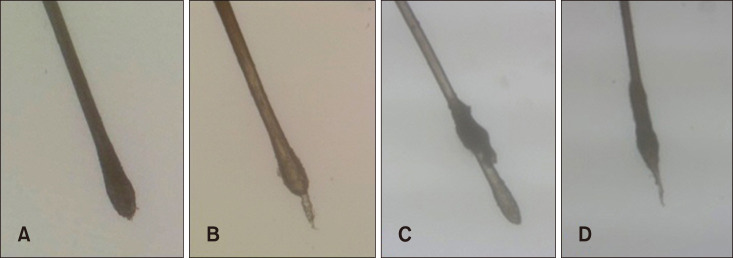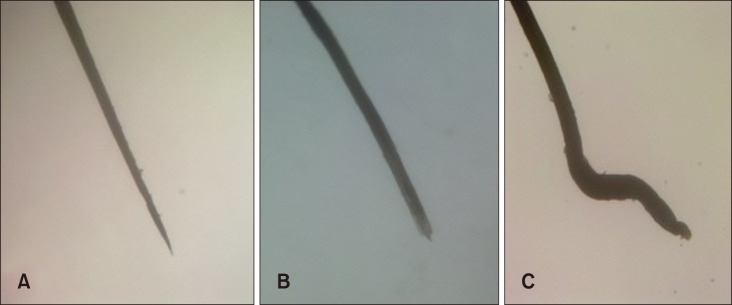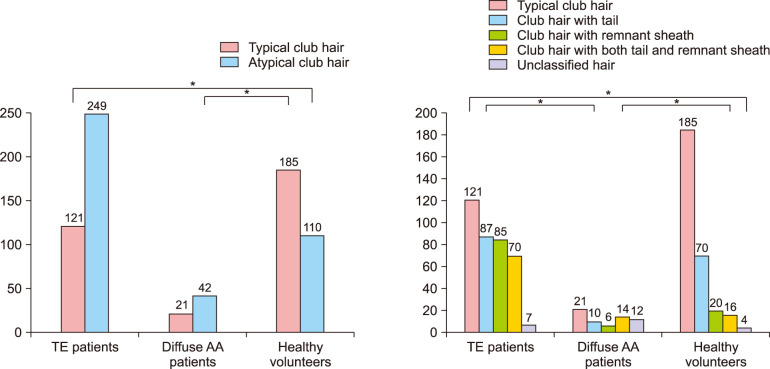Ann Dermatol.
2020 Apr;32(2):141-145. 10.5021/ad.2020.32.2.141.
Analysis of Microscopic Examination of Pulled Out Hair in Telogen Effluvium Patients
- Affiliations
-
- 1Department of Dermatology, Busan Paik Hospital, Inje University College of Medicine, Busan, Korea. derma09@hanmail.net
- KMID: 2471340
- DOI: http://doi.org/10.5021/ad.2020.32.2.141
Abstract
- BACKGROUND
Telogen effluvium (TE) is characterized by massive hair shedding and results from an abrupt conversion of anagen to telogen. Differentiation of TE with other hair disorders showing massive hair shedding is difficult.
OBJECTIVE
To evaluate the morphologic characteristics of pulled out hair of TE.
METHODS
We analyzed microscopic examination of pulled out hairs by hair pull test in TE patients, and compared these hairs with pulled out hairs in diffuse alopecia areata (AA) patients and healthy volunteers.
RESULTS
Hair microscopic examination in 44 TE patients (370 hairs) and 30 healthy volunteers (295 hairs) were as follows: typical club hair, 32.7%, 62.7%; club hair with tail, 23.5%, 23.7%; club hair with remnant sheath, 23.0%, 6.8%; club hair with both tail and remnant sheath, 18.9%, 5.4%; and unclassified hair, 1.9%, 1.4%. The examination in 7 diffuse AA patients (63 hairs) was as follows: typical club hair, 23.9%; atypical club hair, 47.7%; and distinctive AA hair, 28.4%. There was statistical difference between TE patients and healthy volunteers group (p=0.000).
CONCLUSION
Increased atypical club hair in microscopic hair examination might be characteristics of TE.
Keyword
Figure
Reference
-
1. Grover C, Khurana A. Telogen effluvium. Indian J Dermatol Venereol Leprol. 2013; 79:591–603. PMID: 23974577.
Article2. Shapiro J. Clinical practice. Hair loss in women. N Engl J Med. 2007; 357:1620–1630. PMID: 17942874.3. Mubki T, Rudnicka L, Olszewska M, Shapiro J. Evaluation and diagnosis of the hair loss patient: part I. History and clinical examination. J Am Acad Dermatol. 2014; 71:415.e1–415.e15. PMID: 25128118.4. McDonald KA, Shelley AJ, Colantonio S, Beecker J. Hair pull test: evidence-based update and revision of guidelines. J Am Acad Dermatol. 2017; 76:472–477. PMID: 28010890.
Article5. Hillmann K, Blume-Peytavi U. Diagnosis of hair disorders. Semin Cutan Med Surg. 2009; 28:33–38. PMID: 19341940.
Article6. Shapiro J, Wiseman M, Lui H. Practical management of hair loss. Can Fam Physician. 2000; 46:1469–1477. PMID: 10925761.7. McElwee KJ, Sinclair R. Hair physiology and its disorders. Drug Discov Today Dis Mech. 2008; 5:e163–e171.
Article8. Hardy MH. The secret life of the hair follicle. Trends Genet. 1992; 8:55–61. PMID: 1566372.
Article9. Jackson AJ, Price VH. How to diagnose hair loss. Dermatol Clin. 2013; 31:21–28. PMID: 23159173.
Article10. Alkhalifah A, Alsantali A, Wang E, McElwee KJ, Shapiro J. Alopecia areata update: part I. Clinical picture, histopathology, and pathogenesis. J Am Acad Dermatol. 2010; 62:177–188. quiz 189–190. PMID: 20115945.11. Otberg N. Primary cicatricial alopecias. Dermatol Clin. 2013; 31:155–166. PMID: 23159184.
Article12. Van Neste D, Leroy T, Conil S. Exogen hair characterization in human scalp. Skin Res Technol. 2007; 13:436–443. PMID: 17908196.
Article13. Hoffmann R. TrichoScan: combining epiluminescence microscopy with digital image analysis for the measurement of hair growth in vivo. Eur J Dermatol. 2001; 11:362–368. PMID: 11399546.
- Full Text Links
- Actions
-
Cited
- CITED
-
- Close
- Share
- Similar articles
-
- Hair Follicles of Anterior Parietal Region are More Vulnerable than Occipital Region in Classic Acute Telogen Effluvium
- Localized Telogen Effluvium Following Hair Transplantation
- Corrigendum: Analysis of Microscopic Examination of Pulled Out Hair in Telogen Effluvium Patients
- Analysis of Serum Stored Iron Levels in Female Chronic Telogen Effluvium
- Two Cases of Telogen Effluvium after COVID-19 Infection




